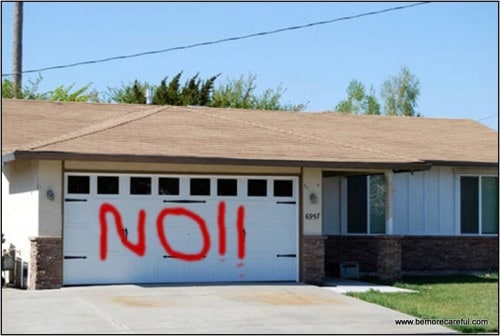I saw this on the national cable news two nights ago, the horrifying story of a Denton TX woman whose house was basically destroyed by a bulldozer. Was it a runaway bulldozer? Nope, different type of “accident.”
Workers were supposed to tear down the house across the street (oops, indeed). See this article: “Texas Woman At A Loss For Words After Workers Demolish Wrong House” and this picture.
Clearly, a huge sign on the garage saying “WRONG HOUSE” might have helped, but that's not a practical precaution we can all take in the morning when we leave for work. Keep reading for some questions about why we rely on signs and cautions in the workplace, particularly hospitals.
 Posting notices like this can have some benefit – think of situations where surgeons and/or patients mark “NO” or “wrong side” to help prevent a wrong-side surgery error, as in this picture below (thanks to my friend Blair for giving me a picture of her husband's broken clavicle). This picture is clearly the non-broken one.
Posting notices like this can have some benefit – think of situations where surgeons and/or patients mark “NO” or “wrong side” to help prevent a wrong-side surgery error, as in this picture below (thanks to my friend Blair for giving me a picture of her husband's broken clavicle). This picture is clearly the non-broken one.
I'm not saying they shouldn't have marked his clavicle. That warning is just one way, an imperfect one, to assure quality. Too many hospitals, in many other situations, try to manage quality and safety through the posting of signs. Lots and lots and LOTS of signs. You see them everywhere.
Posting signs hardly ever gets to the root cause of why people aren't following a process. What broke down in the process that allowed someone to start demolishing the wrong house? What would break down to lead a surgeon to operate on the wrong side of the body, in a case less obvious than the broken clavicle?
Posting “cautions” and “warnings” and “be carefuls” hardly ever leads to perfect quality since, guess what, we're human. We're going to make human errors. Frequently.
Good system design takes this into account. That's a common theme in aviation safety, patient safety, and the Lean methodology.
If you think posting a “Don't knock me down” sign on your house each morning is silly, what about the workplace? Why are “don't make errors” signs any more effective in the workplace? Do you want to paint this on your garage door?
Tim McMahon (@timaleanjourney) tweeted about this wrong house story and, in our discussion, we agreed that it's better to paint “THIS HOUSE” on the one you ARE supposed to knock down, which is in parallel to the “universal protocol” operating room standard that says you are supposed to mark the location you DO want to cut.
It's not practical to mark every possible wrong site (although I do think “wrong knee” is a good double check — mark the site AND the wrong side as such). Even in the “obvious” clavicle case, it's a good practice to ALWAYS follow the universal protocol. You can see his other clavicle (I'll spare you the sight) is clearly broken. But, say with an ACL repair knee surgery, you can't SEE which one needs obvious repair.
The universal protocol only has exceptions when it's a “midline” surgery where wrong-side is not possible or an issue.
Another Example
One hospital I visited recently (I don't have pictures) had warnings in the hallway saying, basically, be careful and don't slip on the floors.
Why would you slip on the floors? Because of all of the paraffin (wax) that was tracked into the hallway from the nearby pathology lab (wax is used in the process of making slides of patient specimens).
Better than signs would be some root cause analysis about WHY the paraffin gets into the hallway. What can be done to PREVENT the tracking of wax out into the public hallway.
A New Blog on This Topic
I have a collection of such signs, combined with signs from a few anonymous collaborators. I've started a small experiment with a specific photoblog called BeMoreCareful.com. It's a collection of similar signs – cautions and warnings that probably aren't very effective (not the clavicle example)/
Take a look at the site – if you have similar pictures, you can send them to me.
Everything will be anonymous – names and organizations. I'm not looking to embarrass anyone individually. This is an industry-wide problem. I think we need to shed light on signs being a SYMPTOM of a problem, not the solution.
The new blog is a bit of a lark, cobbled together in a few hours. Let's see how the experiment goes, if this will grow to be a community effort. This is sort of a soft launch… the site could run its course in a few weeks.
Please scroll down (or click) to post a comment. Connect with me on LinkedIn.
Let’s build a culture of continuous improvement and psychological safety—together. If you're a leader aiming for lasting change (not just more projects), I help organizations:
- Engage people at all levels in sustainable improvement
- Shift from fear of mistakes to learning from them
- Apply Lean thinking in practical, people-centered ways
Interested in coaching or a keynote talk? Let’s talk.
Join me for a Lean Healthcare Accelerator Trip to Japan! Learn More











Mark–the link you posted to bemorecareful.com actually goes to leanpub.com.
Nice subject, though.
I will fix that later. I should have been more careful!!!!
[…] See http://www.leanblog.org for a more detailed post on this scenario and warning signs on 4/30 (direct link) […]
Believe it or not — similar story in the news, this time from Fort Worth, TX:
City Subcontractor Demolished Wrong House
The article suggests that keeping your house from looking “junky” might be good error proofing?
Still, this sort of thing shouldn’t happen.
Confirm address twice, then demolish.
And it happened AGAIN in Fort Worth:
City Of Fort Worth Demolished Wrong Home For A Second Time